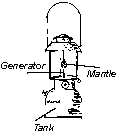|
Standards
A 1, 2
B 1
D 1, 4
|
|
Concepts
Evaporation
Surface area
Forms of Energy
|
|
For many years, before electricity was made available to Alaska
villages, people used gas lamps and stoves as everyday household
items. Now, they are used on hunting and camping trips and in fishcamps,
but seldom in homes. A magazine stated, “Gas lamps hiss and
clank and blind you just like civilization.” Not everyone agreed
with that, but everyone does agree that they hiss and clank. Gas
lamps give a strong white light, making bright spots and dark shadows
in a room. Today, hunters use them to follow a blood trail in the
dark, and fishermen use them to spear fish at night.
One of the few good things about a gas lamp is that you can turn
it off and jump in bed before the light goes out.
|
| |
 Main
Parts Main
Parts
There are three main parts to a gas lamp:
- The tank
- The generator
- The mantle
Tank
The tank holds the fuel. The pump creates and holds the pressure
that forces the fuel up, over and through the generator.
|
| |

|
Generator
The generator is responsible for preheating the fuel and air.
The generator is to the gas lamp what a carburetor is to an engine.
They both mix fuel and air in the proper amounts.
Preheating the Fuel
As the fuel passes through the heated generator, it actually boils,
turning into a vapor in the generator. If the fuel burned on the
mantle as a cool spray, it wouldn’t have enough surface area
to burn thoroughly. When it is vaporized in the generator, it is
broken into tiny droplets with great surface area. The vapor emerges
through the screen which spreads the vapor evenly into the mantle
where it is burned.

Fuel Drops
Vaporized
Fuel
Importance of vaporizing the fuel
 If you
try to ignite a block of wood with a match, it has too much mass
and not enough surface area to sustain burning. If you split it
into small pieces, and make shavings to further increase the surface
area, that same block of wood will burn quickly and thoroughly.
This same principle is applied when liquid fuel is heated to a vapor,
drastically increasing the surface area available for combustion. If you
try to ignite a block of wood with a match, it has too much mass
and not enough surface area to sustain burning. If you split it
into small pieces, and make shavings to further increase the surface
area, that same block of wood will burn quickly and thoroughly.
This same principle is applied when liquid fuel is heated to a vapor,
drastically increasing the surface area available for combustion.
|
| |
Practical Proofs
This point is illustrated when we first light the lamp. It burns
with a rough yellow flame until the heat from that flame preheats
the fuel in the generator.
It is again illustrated when the generator is dirty. The soot
on the generator insulates the fuel from the heat of the flame.
It takes a long time for the fuel to vaporize. As soon as the generator
is cleaned, it will again conduct heat to the fuel to vaporize it.
Gasoline mixed with two-cycle oil spoils a generator almost instantly.
|
| |
Preheating the Air
Preheating the air as it passes through the generator is important
because there are three things necessary for fire to occur:
If one of these is removed, the fire will go out. If the air is
cold, it will slow the burning. Preheating the air in the generator
helps keep the temperature high enough to support combustion.
|
|
Glass keeps
the heat in

|
Temperature
In homes, people often removed the glass that surrounds the generator
and mantle as it gets in the way of lighting the lamp. The lamp
is brighter without it. However, we use gas lamps to spear whitefish
at night in the fall. Without the glass to retain heat within the
lamp, the lamp doesn’t get warm enough to burn well at all.
Only with the glass in place to retain heat do they work in low
temperatures.
When fishing at night, we put the lamps in a five-gallon can that
is open on one side. This keeps the light out of our eyes, reflects
more light ahead, and holds heat for the lamp.
|
 Danger Danger
The heat above a burning gaslamp in the house is so great there
is a considerable fire hazard. People often put shiny reflectors
between the rising heat and the wood frame of the house. Lamps are
hung on metal hooks far below wood surfaces.
Mantle
The mantle material, which is really an ash, is very fragile.
If there were no mantle, a gas lamp would be like a blowtorch. There
would be considerable heat, but little light from the flame. As
the heat of the flame heats the mantle, it glows brightly, changing
much of the heat energy to light energy. Older mantles actually
contained radioactive materials.
Burn a new mantle outside, and don’t breathe the fumes.
|

|
| |
 Screen Screen
There is a screen at the mouth of the generator where the fuel
and air pour into the mantle. The screen does two jobs.
- It spreads the fuel/air mixture so combustion is even.
- It retains heat so combustion takes place on or around its surface.
It is not a chemical catalyst.
If a screen is damaged, the lamp gives off a roaring sound and
combustion is uneven.
|
| |
Gas Stove
A gas stove works the same as a gas lamp, except there is no mantle.
The desired result is heat to cook with, not light to see by.
The fuel comes from the pressurized tank through the generator
which passes through the flame. As the fuel is heated, it turns
to a vapor. When it emerges, it burns with a hot blue flame.

The color of the flame indicates what is being produced by the
combustion of the fuel.
When fuel is burned and carbon monoxide is produced, the flame
is yellow.
A carbon dioxide flame is blue.
A yellow flame produces only one-third of the heat energy of a
blue flame!
Recently, we were traveling in our van. I wondered if I should
get a gas stove or a propane stove. I decided on a gas stove. Propane
under pressure can leak in the small area of the van and explode.
The pressure of a gas stove can be released. It is safe to store
in tight places. Gas stoves are lighter and cheaper to carry on
camping trips in the boat and sled than propane stoves and tanks.
However, gas stoves aren’t as convenient as propane stoves.
|

|
Activities
- Put a little (room temperature) gas lamp fuel in your hand.
Blow on it. Does it feel cold? Why? Put a little room temperature
stove oil in your hand. Blow on it. Does it feel as cold? Why?
Can you explain why we don’t use stove oil in a gas lamp?
- Cut two identical blocks of wood. Split one into four parts.
Split the other into small kindling. Make two campfires of the
same size. Put the split pieces of the first block on one and
the split pieces of the second on the other. Which burns faster?
How much faster? What can you say about increasing the surface
area of fuel?
- First light an old gas lamp. Let it cool down, then take the
generator out. If you are careful you can do it without breaking
the mantle. Is it black with soot? Scrape it clean with a pocket
knife or sandpaper. Reinstall it, and light the lamp again. Can
you tell the difference between before and after? What is the
difference and why?
- Observe. What do you suppose the little needle is for on the
end of the generator you just removed?
- Get someone with the necessary knowledge to show you how to
replace a mantle. While the old mantle is off, inspect the screen.
Does it have any holes?
- If possible, research what kind of material is used in the
mantle of a gas lamp. How is the material unique?
- Pump the tank full of pressure. Release the pressure. Lubricate
the pump with a few drops of oil, and pump the tank again. Is
there a difference? Why?
- Ask people in your village if they use gas lamps outdoors in
the past. Do they still use them in hunting, whaling, or fishcamps?
- Light a gas stove. Identify the parts of the flame that are
producing carbon dioxide. Identify the parts of the flame that
are producing carbon monoxide.
- With the same amount of water at the same temperature in the
same teapot, time how long it takes to boil water on the gas stove,
on a propane stove, and on an electric stove. Which is faster?
Which do you think is more convenient? Which do you think is safer
in the house?
- With pliers, hold a piece of a broken mantle in the flame of
a candle or gas stove. Does it glow?
|

|
Student Response
- What are the three main parts of a gas lamp?
- What is the main purpose of the generator?
- What happens to fuel in the generator?
- Draw a picture of fuel as a liquid and the same amount of fuel
as a vapor.
- Why does the generator pass over the flame in both the gas
lamp and gas stove?
- The screen in a gas lamp does two things. What are they?
- Why do whitefish hunters have a hard time with their gas lamps
in cold temperatures and what is the cure?
- What color is the flame when carbon monoxide is produced? What
color is the flame when carbon dioxide is produced?
- Which is more efficient in the production of heat: combustion
to carbon monoxide or combustion to carbon dioxide? By what ratio?
|

|
Math
- If a blue propane flame gives off 1500BTU1 how many BTU are
given off if the air adjustment is wrong and the flame is completely
yellow? (Blue flame: CO2 z xBTU, Yellow flame: CO2 z 1/3x BTU)
- A 5 gallon can of Blazo fuel costs $38. It lasts Mark 3 months
in his trapping cabin. A bottle of propane lasts him 7 months
at home. Propane is $105. Which is cheaper per month?
- Gas lamps don’t work well with leaded gas. But Blazo fuel
is $8 a gallon, and leaded gas is $2.25 a gallon. New generators
are $1.98 apiece. Mark is wondering if it is cheaper to burn cheaper
fuel and change generators once a week or whether it is cheaper
to burn the correct fuel. Which method is cheaper if a gallon
of fuel lasts three weeks?
|
|






 Main
Parts
Main
Parts If you
try to ignite a block of wood with a match, it has too much mass
and not enough surface area to sustain burning. If you split it
into small pieces, and make shavings to further increase the surface
area, that same block of wood will burn quickly and thoroughly.
This same principle is applied when liquid fuel is heated to a vapor,
drastically increasing the surface area available for combustion.
If you
try to ignite a block of wood with a match, it has too much mass
and not enough surface area to sustain burning. If you split it
into small pieces, and make shavings to further increase the surface
area, that same block of wood will burn quickly and thoroughly.
This same principle is applied when liquid fuel is heated to a vapor,
drastically increasing the surface area available for combustion.


 Danger
Danger Screen
Screen